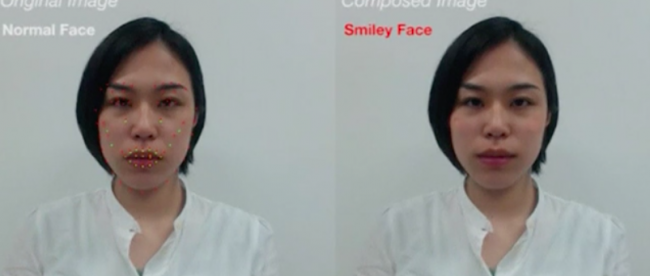The Mirror That Smiles Back

While we can see the world around us with our own eyes, we can’t see ourselves. But we have a good solution for that: mirrors. The purpose of a mirror — fun houses aside — is to give us an accurate reflection of reality. And because of that, sometimes we see something unexpected. This can affect our mood — if we see something we don’t like, it may upset us, and if we’re pleasantly surprised by something (a really good hair day, maybe?), maybe the experience will put a little bounce in our step.
And that’s ripe for manipulation.
In 2013, a researcher at the University of Tokyo named Shigeo Toshida came up with an idea: a mirror which smiles back. As Fast Company reported, the device — called the “Incendiary mirror” — isn’t actually a mirror. It’s a monitor with a camera and computer hooked up to it. The camera captures the image of your face and the software makes a map of it, identifying your various features.
Once mapped, the software displays an image of the person with subtle, almost imperceptible changes. If you look at the “mirror” with a stoic, serious face, you’ll see yourself looking back but with the beginnings of a smile forming. Your cheeks are raised a little, your mouth elongated a little, and the face looking back at you appears to be in a good mood. Subliminally speaking, that is. Here’s a screenshot from a video about the incendiary mirror (via Yahoo, in case you want to watch it), and you can see the facial mapping on the left and the ever-so-slight changes on the right.

Toshida’s research team instructed 21 volunteers to “perform a neutral task and then to rate how they felt while gazing into the pane of falsification,” as Slate artfully described. The results were clear. Tokyo Weekender reported, that “those who saw happier images of them said they felt a sense of euphoria, while some who saw a gloomier version reportedly felt somber.” In a sense, the fake smile became real.
But the research team didn’t stop there. They wondered, could someone monetize this forced happiness? And it turns out, yes, you could. Slate continued:
Each person was also given a scarf to wear and placed in front of either a regular mirror or a speculum of dissemblance [that’s the incendiary mirror]. Volunteers who saw altered, sunnier figments staring back at them were more likely to be enchanted by the scarf than were members of the control group. Toshida and his colleagues believe their device, given dominion over a dressing room, “could be used to manipulate consumers’ impressions of products,” persuading people to buy clothes they might otherwise turn down.
Deceitful? Sure. But if you’re trying to sell clothes and accessories, it makes sense that making people think they look happier wearing those products would lead to increase sales.
Don’t worry about this happening in a dressing room near you anytime soon, though. While seeing yourself with a slight smile may make you a bit happier, finding out that there’s a camera watching you in the dressing room mirror — that’s probably going to make you kind of mad, defeating the whole purpose.
Bonus fact: Ever wonder why mirrors are often placed in or around elevators? It’s because they’re boring. The elevators, that is. Waiting for them is boring as is riding in them. And when people are bored, they complain. The mirrors give them something to do, as the New York Times explains: “The idea was born during the post-World War II boom, when the spread of high-rises led to complaints about elevator delays. The rationale behind the mirrors was similar to [. . . ] give people something to occupy their time, and the wait will feel shorter. With the mirrors, people could check their hair or slyly ogle other passengers. And it worked: almost overnight, the complaints ceased.”
From the Archives: Temporary Blindness: The one thing you can’t see in the mirror.
